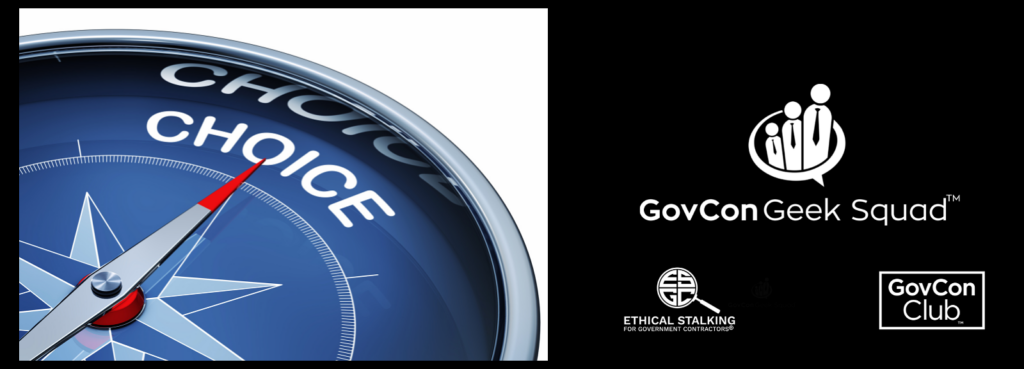Customer versus Buyer

I’m going to mince words with you to help you make a choice. The choice is not about one versus the other, but at what time and how much time you allocate. Here’s the mincing. What makes someone your Customer in Government Contracting? What makes them your Buyer? My real question is, does it matter to you?
Many companies selling, and aspiring to sell goods and services to the U.S. Government, are courting Contracting Officers to find and win contracts. This isn’t new. In fact, companies taking action on partial or unsubstantiated beliefs is common. If you doubt this, think about NAICS Codes, GSA Schedules, MACs and GWACs. Stories of each is shared in gospel-like fashion throughout the many tribes in Government Contracting, although much of what is conveyed is not accurate. It is widely believed by many doing the work and many claiming expertise that:
- NAICS Codes are the end-all classification code to use in advertising and market research (despite the fact they are not the foundational taxonomy used to represent WHAT agencies are buying in Category Management, and in the PSC Code Manual).
- GSA Schedules are the most widely used procurement method (although GSA and VA Schedule combined fiscal sales account for less than ten percent of the overall fiscal spend).
- Multiple Award Contracts (MAC) represent the bulk of fiscal federal spending (when the truth is obligations to multiple-award contracts in FY2020 accounted for less than 25% of the fiscal spend).
- Governmentwide Acquisition Contracts (GWAC) are any multiple-award contract issued by any agency (but the truth is, they are an OMB designated, competitively awarded, IT Mission Support contract vehicle that as of today, are only issued by GSA, NASA and NIH/NITAAC).
The lack of clarity regarding this terminology and the role of a Contracting Officer isn’t a showstopper, but it can and will slow things down for you. Not having proper context can have you looking in the wrong places for the right information, and it can lead to you using that less than relevant information in your decision-making. All of this contributes to missing important deadlines, and worse, giving your competition time to catch or even surpass you in the race of making good and timely decisions.
So, let’s talk about Contracting Officers, also known as COs and KOs. The former is used to describe buyers in Civilian agencies, and the latter for Defense agencies. Why the difference? In the military, a CO is a Commanding Officer, so KO is a way to distinguish the Buyer from the Boss. This could get even more confusing if the Commanding Officer of a Contracting Activity in the Army, Navy, Air Force or Marines, was also a Contracting Officer. I’ll ask my friend Rhino about that next time I talk to him. In a previous life, Rhino was an Air Force officer and a contracting officer. On two occurrences, he was the Branch Chief of a Joint Contingency Contracting Command in Iraq, and the Branch Chief of a Regional Contracting Command for CENTCOM, but in between those two stints, he was Commander of a Contracting Squadron. That means he was both a CO and KO, at the same time.
For ease, let’s refer to the CO, KO (includes Procuring Contracting Officers, Administrative Contracting Officers, Termination Contracting Officers, just to name a few)) and all of the other professionals such as Contract Specialists, Procurement Analysts, and Purchasing Agents collectively, as the Buyer.
Make no mistake, the Buyer is central to the execution of a procurement. After all, those individuals with a GS-1102 designation and a warrant issued by Congress, are legally authorized to contractually bind the U.S Government. This is a feat that no head of an agency or even the POTUS can pull off because they don’t have signature authority. So if it’s got to be purchased, you need a Buyer. Of course, there are some exceptions to the rule that accounts for roughly $22 billion of agency spending during FY2020. This left nearly $650 billion in contract actions requiring the authority and knowledge of the Buyer.
Here’s what’s missed by many.
There is a LOT happening in other parts of a federal agency or defense organization with people who are not the Buyer, for weeks, months, or even years before the skills of the Buyer are needed. This is the domain of the Customer, also known as the individual or group submitting requisitions, end-user, program office, funding office and more. The Customer has a whole world of decisions to make as they work to achieve the objectives of their organization. However, decisions regarding who to buy from or how to effect the purchase, are generally, not on that list.
So, when it comes to Customer versus Buyer and does it matter, you just need to decide when you want to have visibility into business opportunities. If your answer is Customer, then do what it takes to separate yourself from the crowd by truly getting in front of opportunities. Start by spending time learning about and getting to know your Customer and what’s important to them, before the buying starts.
Peace,
Go-To-Guy
P.S. We also have a Squadcast episode on this subject, so be sure to check it out!